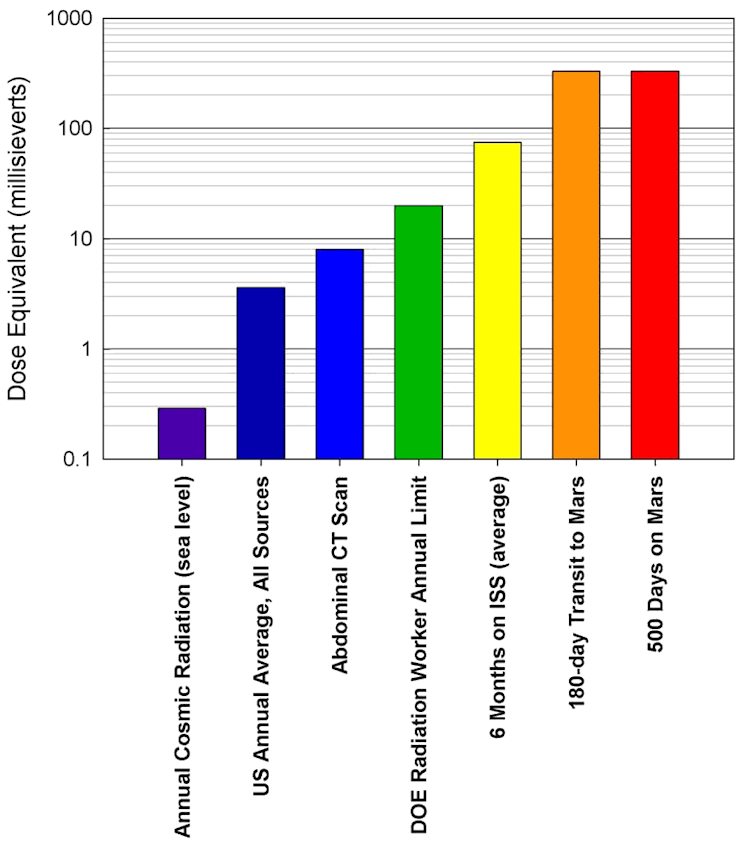In a decade or two, trips into space could be as commonplace as transatlantic flights. In particular, there will be a significant increase in the number of people traveling into space with the help of commercial companies, such as Virgin Galactic and Blue Origin.
But such travel comes with huge radiation risks. Sudden changes in space weather, such as solar flares, for example, can have significant health implications for crew and passengers. Now our recent paper, from the University of Surrey, Foot Anstey LLP’s Space and Satellite Team, found that current legislation and regulation does not do enough to protect space tourists and crew.
Changes in space weather could expose space tourists to radiation doses exceeding the recommended maximum of 1 millisert (mSv) annually for a member of the public and 20mSv per year for those who work with radiation. Research at the University of Surrey shows that flight participants could receive doses in excess of 100mSv during an extreme space weather event.
Current legislation and regulation addressing the potential radiation exposure of space tourists is limited and largely untested. There is a strong emphasis on normal non-radiation risk and wider safety, with guidance arising from the regulation of normal commercial flights. However, there is a significant difference between these and space tourism enterprises.
Likewise, the law regarding space flights and the risk liability associated with them is complex. Space law comprises a combination of international law (such as international agreements, treaties and conventions), domestic legislation and guidance.
Cancer risk
Exposure to low levels of natural background radiation is part of everyday life. Most people are unaware of this exposure and the potential risks to our health. For example, an effective dose of 0.08mSv from a commercial flight from the UK to the USA.
However, exposure to elevated levels of ionizing radiation, such as those possible during space weather events, may result in DNA damage. The risk associated with space travel therefore ranges from a minor increase in health defects to serious health implications such as cancer.

A significant risk assessment of radiation exposure to Earth was carried out; for example in the nuclear industry. This is unlike the space tourism industry, which is still in its infancy.
Previous research has focused on assessing potential risk to astronauts from radiation exposure and long-duration missions beyond low-Earth orbit. But this does not consider risks for those on short trips to space as tourists. Thus, significant work remains to be done to assess the unique risk of space tourism flights and the supporting guidance and regulation.
Any existing regulation, such as the United Kingdom’s Air Navigation Ordinance and the Federal Aviation Administration (FAA), applicable to potential space flights focuses on crew, rather than paying passengers.
The space tourism industry is not fully aware of the radiation risks, we found. Rather it relies on incomplete “informed consent” for non-team participants. Current industry regulation therefore places the burden of risk firmly on space tourists. We argue that more legislation and regulation is needed.
Our recommendations
We made a series of recommendations in our report. But they are advisory. They are intended for industry and regulators to consider as the space tourism sector continues to develop, particularly the FAA and the UK Civil Aviation Authority (CAA).
We encourage these bodies to collaborate with industry, including space tourism companies, spacecraft manufacturers and space research organizations, to understand the technical challenges and risks associated with new spaceflight activities. Such collaboration would help ensure that regulations are practical, effective and reflect the latest technological advances.
We also recommend looking at international standards. As the commercial space industry becomes more global, it will be important for the CAA and FAA to cooperate with international regulatory bodies elsewhere, such as the International Civil Aviation Organization (ICAO) and the United Nations Committee on the Peaceful Uses of Outer Space ( Uncopuos). ), develop consistent regulations that apply across multiple jurisdictions.
Safety should be a critical consideration for any new regulations related to spaceflight. The CAA and the FAA will need to ensure that new regulations adequately address the risks associated with spaceflight. This is particularly the exposure to radiation, but also the potential for accidents or system failures.
Finally, we encourage innovation. The commercial space industry is characterized by rapid innovation and technological advancement. No new regulations should hinder this innovation. The CAA and FAA will need to develop regulations that strike a balance between promoting safety, encouraging the development of new technologies and approaches, and enabling industry growth.
Ultimately, the CAA and the FAA will need to be flexible and adaptive. As the industry continues to develop, they should review and update regulations to ensure they remain relevant and effective.
This article from The Conversation is republished under a Creative Commons license. Read the original article.


Chris Rees does not work for, consult with, own shares in or receive funding from any company or organization that would benefit from this article this, and has disclosed no relevant affiliations beyond their academic appointment.